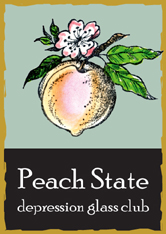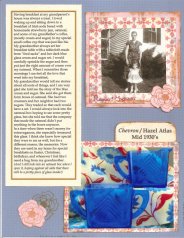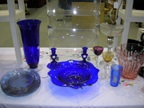Preserving the Past
Scrap Your Glass
Wait a minute; did I just hear someone say, ďScrap your glass?Ē...
I would never do that; I love my glass, why would I want to throw it away? My collection includes glass from my mother and grandmother and my aunt and my motherís best friend, I would never discard it, but I am concerned about what will happen to my glass when Iím gone. My family is just not interested. Iím sure it will end up in a yard sale or thrift store. What can I do to help them appreciate the items I treasure?
Let me suggest an idea; scrap your glass and your memories. Yes, you heard me; you just didnít understand what I meant, so let me explain! "Scrap" is short for scrapbooking, and sometimes used as the term for the process of making a scrapbook. Most pieces of glass that are special to you have a story behind them. In one of my scrapbook pages I describe how my grandmother received a cobalt creamer and sugar bowl from a local gas station as a premium, memories of the set on her breakfast table, and the warm feelings when using it to put the sugar and cream into my bowl of oatmeal, and how it found itís way to my table for holiday breakfasts. So, letís turn your glass and stories into a scrapbook that can be shared with your family and passed down to future generations.
Scrapbooking is very popular and there are plenty of resources at your disposal. To properly preserve your memories you will need to use archive quality products that are acid and lignin free, including papers and glues. Local scrapbook and craft stores and home-based scrapbooking businesses have classes and products to help you get started. Books magazines and websites abound, just choose the one that reflects your style.
If you are new to scrapbooking donít be intimidated by elaborate layouts. The purpose of your scrapbook is to preserve your memories. There is no right or wrong way. As long as your page includes a photo of the glass, and the person associated with the glass, along with a brief story you have the basics. You can make it very simple or as creative as the ones you find in magazines. The important thing to remember is that it is about the glass and the memories it holds for you. Donít feel overwhelmed, just start with one piece and write your first story about it. In scrapbooking this is called journaling. It tells your history through glass in your own words and is a very important part of the scrapbook. Good journaling answers the basic questions "Who, What, When, Where, and How?" Get family members interested in your glass by asking them to help with the scrapbook. Some may already be avid scrappers interested in taking on a new project to document family history. Others may be interested in taking photos or helping with journaling.
Scrapbooking your glass is a fun and worthwhile project, and a creative and personal way to share your stories. Your family and friends will appreciate the captured memories. By telling them why the glass is special you have given them a reason to keep your treasured items. They are no longer just pieces of glass, but family heirlooms with a rich history.
Scrapbooking can also be an opportunity to inventory your glass. Photos can be used for documentation, and there are several creative ways to add the inventory list to your scrapbook page.
I will be presenting a seminar titled ďPreserving the PastĒ at the 35th Annual Collectable Glass Show and Sale in Marietta, Georgia in July.
Resources to help you get started:
- Creating Keepsakes Magazine & online
- Creative Memories (home based scrapbooking)
- Archivers Scrapbook store & online
- Craft Stores: Michaels, Joannís, A.C. Moore, Hobby Lobby
Submitted by Lorna Hart
National Depression Glass Association Newsletter
May/June 2011
www.ndga.net




